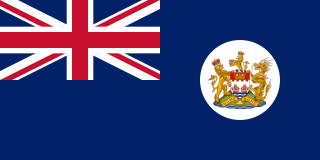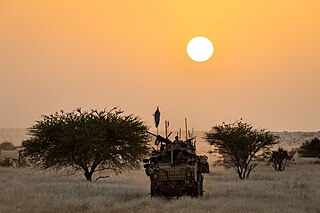Related Research Articles

The Royal Armoured Corps is the armoured arm of the British Army, that together with the Household Cavalry provides its armour capability, with vehicles such as the Challenger 2 and the Warrior tracked armoured vehicle. It includes most of the Army's armoured regiments, both the Royal Tank Regiment and those converted from old horse cavalry regiments. Today it comprises twelve regiments, eight regular and four Army Reserve. Although the Household Cavalry Regiment provide an armoured regiment, they are not part of the RAC.

Yeomanry is a designation used by a number of units and sub-units in the British Army Reserve which are descended from volunteer cavalry regiments that now serve in a variety of different roles.
The 2003 Defence White Paper, titled Delivering Security in a Changing World, set out the future structure of the British military, and was preceded by the 1998 Strategic Defence Review (SDR) and the 2002 SDR New Chapter, which responded to the immediate challenges to security in the aftermath of the September 11 attacks in 2001. Published under the then Secretary of State for Defence, Geoff Hoon, the report effectively introduced a series of cutbacks to core equipment and manpower and the scaling back of a series of future capital procurement projects. This was justified due to the implementation of a policy termed Network Enabled Capability. The review also outlined a major restructuring and consolidation of British Army Infantry regiments.
Colonel-in-chief is a ceremonial position in a military regiment. It is in common use in several Commonwealth armies, where it is held by the regiment's patron, usually a member of the royal family.

British Forces Overseas Hong Kong comprised the elements of the British Army, Royal Navy and Royal Air Force stationed in British Hong Kong. The Governor of Hong Kong also assumed the position of the commander-in-chief of the forces and the Commander British Forces in Hong Kong took charge of the daily deployment of the troops. Much of the British military left prior to the handover of Hong Kong to China in 1997. The present article focuses mainly on the British garrison in Hong Kong in the post Second World War era. For more information concerning the British garrison during the Second World War and earlier, see the Battle of Hong Kong.
The Army School of Bagpipe Music and Highland Drumming is a British Army training establishment that provides instruction on Scottish pipe band music to military pipers and drummers.
The British Army is listed according to an order of precedence for the purposes of parading. This is the order in which the various corps of the army parade, from right to left, with the unit at the extreme right being highest. Under ordinary circumstances, the Household Cavalry parades at the extreme right of the line. Militia and Army Reserve units take precedence after Regular units with the exception of The Honourable Artillery Company and The Royal Monmouthshire Royal Engineers.

The 10th Armoured Division was an armoured formation of division-size of the British Army, raised during the Second World War and was active from 1941–1944 and after the war from 1956–1957. It was formed from the 1st Cavalry Division, a 1st Line Yeomanry unit of the Territorial Army (TA) which had previously been serving in Palestine. The division was converted from cavalry to armour and redesignated from 1 August 1941.
The 1957 White Paper on Defence was a British white paper issued in March 1957 setting forth the perceived future of the British military. It had profound effects on all aspects of the defence industry but probably the most affected was the British aircraft industry. Duncan Sandys, the recently appointed Minister of Defence, produced the paper. The decisions were influenced by two major factors: the finances of the country and the coming of the missile age.

There are 13 cavalry Regiments of the British Army each with its own unique cap badge, regimental traditions, and history. Of the currently nine regular cavalry regiments, two serve as armoured regiments, three as armoured cavalry regiments, three as light cavalry, and one as a mounted ceremonial regiment. There are also four yeomanry regiments of the Army Reserve, of these, three serve as light cavalry and one as an armoured regiment. Each yeomanry light cavalry unit has been paired with a regular unit of the same role, the armoured yeomanry unit is paired with the two regular armoured units. All except the Household Cavalry are part of the British Army's Royal Armoured Corps.

The Queen's Own Yorkshire Dragoons was a yeomanry regiment of the British Army in existence from 1794 to 1956. It was formed as a volunteer cavalry force in 1794 during the French Revolutionary Wars. Its volunteer companies played an active role with the Imperial Yeomanry in the Second Boer War, but opportunities for mounted action were much more restricted during the First World War and it was temporarily converted into a cycle unit. It remained a cavalry regiment throughout the interwar years, and was the last horsed unit of the British Army to see action, in the Syria–Lebanon Campaign of 1941, finally mechanising the following year. It served as motorised infantry in the North African and Italian campaigns of the Second World War. In 1956, it merged with the Yorkshire Hussars and the East Riding of Yorkshire Yeomanry to form the Queen's Own Yorkshire Yeomanry. Its lineage is continued today by A Squadron, the Queen's Own Yeomanry.
In September 1939, the British Army was in process of expanding their anti-aircraft and mobile assets. Among these new changes was the formation of Anti-Aircraft Command which was formed on 1 April 1939, and the 1st Armoured Division formed in 1937. The list below will include the British Army units, colonial units, and those units which were in the process of formation.

The following is a list of the notable Regimental Marches for military regiments of the British Army. In addition, all regiments have additional pieces for slow marches, marches for mounted parades and pipe marches.
The First World War British Cavalry Corps was formed 9 October 1914.

The page contains the current structure of the British Army. The British Army is currently being reorganised to the Future Soldier structure.
The following is a hierarchical outline for the structure of the British Army in 1989. The most authoritative source for this type of information available is Ministry of Defence, Master Order of Battle, and United Kingdom Land Forces, HQ UKLF, UKLF ORBAT Review Action Plan, HQ UKLF, 1990.
Future Soldier is a reform of the British Army resulting from the Integrated Review of Security, Defence, Development and Foreign Policy published in March 2021. The aim of the reform is to create a more lethal, agile and expeditionary force, able to fight and win wars and to operate in the grey-zone between peace and war. Future Soldier was published on 25 November 2021 and deals with the organizational changes of the British Army, with changes to personnel and equipment were set out in the Defence in a Competitive Age paper published on 22 March 2021.
References
- 1 2 "Defence (Options for Change)". Parliamentary Debates (Hansard) . House of Commons. 25 July 1990. col. 468–486.
- ↑ Freedman, Lawrence (18 August 1999). The Politics of British Defence, 1979–97. Macmillan Press. ISBN 0-333746-67-8.
- ↑ Clements, Benedict J.; Schiff, Jerald Alan; Debaere, Peter; Davoodi, Hamid Reza (1 July 1999). Military Spending, the Peace Dividend, and Fiscal Adjustment. International Monetary Fund. ISBN 978-1-4518-9700-5.
- ↑ "End of the Long Lookout". The Herald . Glasgow. 29 December 1995. Retrieved 9 November 2015.
- ↑ "British Army Roll of Regiments 1995". 17 December 2007. Archived from the original on 17 December 2007. Retrieved 20 March 2020.
- ↑ "Regiments & Corps of the British Territorial Army 1995". 17 December 2007. Archived from the original on 17 December 2007. Retrieved 20 March 2020.
- ↑ "British Army units from 1945 on - Welcome". british-army-units1945on.co.uk. Retrieved 20 March 2020.
- ↑ Much information also from the regimental histories available at the army website
- ↑ The term 'union' was used rather than amagalamation, as the regiment continued to maintain their own uniforms, traditions, and regimental titles in the mounted regiment
- ↑ "RAF Timeline 1990–99". Ministry of Defence. Archived from the original on 24 September 2015. Retrieved 9 November 2015.